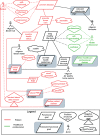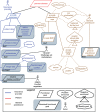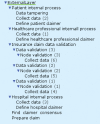Privacy-Conflict Resolution for Integrating Personal and Electronic Health Records in Blockchain-Based Systems
- PMID: 38187955
- PMCID: PMC10770803
- DOI: 10.30953/bhty.v6.276
Privacy-Conflict Resolution for Integrating Personal and Electronic Health Records in Blockchain-Based Systems
Abstract
Integrating personal health records (PHRs) and electronic health records (EHRs) facilitates the provision of novel services to individuals, researchers, and healthcare practitioners. Simultaneously, integrating healthcare data leads to complexities arising from the structural and semantic heterogeneity within the data. The subject of healthcare data evokes strong emotions due to concerns surrounding privacy breaches. Blockchain technology is employed to address the issue of patient data privacy in inter-organizational processes, as it facilitates patient data ownership and promotes transparency in its usage. At the same time, blockchain technology creates new challenges for e-healthcare systems, such as data privacy, observability, and online enforceability. This article proposes designing and formalizing automatic conflict resolution techniques in decentralized e-healthcare systems. The present study expounds upon our concepts by employing a running case study centered around preventive and personalized healthcare domains.
Plain language summary: This paper suggests using blockchain technology for privacy concerns in integrating personal health records and electronic health records in decentralized e-healthcare systems. This report focuses on designing automatic conflict resolution techniques to ensure patient data ownership, transparency, and privacy in inter-organizational processes. This paper proposes designing automatic conflict resolution techniques in decentralized e-healthcare systems, which can improve inter-organizational processes in healthcare. Using blockchain technology to integrate personal and electronic health records can ensure patient data ownership and promote transparency in data usage, addressing privacy concerns in healthcare systems. This paper emphasizes the importance of data privacy and protection in healthcare systems, highlighting the need for compliance with laws and regulations. The research results, including the proof-of-concept prototype, can provide practical insights into implementing conflict resolution techniques in decentralized e-healthcare systems.
Keywords: blockchain; conflict management; e-healthcare; preventive healthcare; privacy; smart contracts.
© 2023 The Authors.
Figures


















Similar articles
-
PatientDataChain: A Blockchain-Based Approach to Integrate Personal Health Records.Sensors (Basel). 2020 Nov 16;20(22):6538. doi: 10.3390/s20226538. Sensors (Basel). 2020. PMID: 33207620 Free PMC article.
-
HealthLock: Blockchain-Based Privacy Preservation Using Homomorphic Encryption in Internet of Things Healthcare Applications.Sensors (Basel). 2023 Jul 28;23(15):6762. doi: 10.3390/s23156762. Sensors (Basel). 2023. PMID: 37571545 Free PMC article.
-
BSF-EHR: Blockchain Security Framework for Electronic Health Records of Patients.Sensors (Basel). 2021 Apr 19;21(8):2865. doi: 10.3390/s21082865. Sensors (Basel). 2021. PMID: 33921738 Free PMC article.
-
Utilizing Blockchain Technology for Healthcare and Biomedical Research: A Review.Cureus. 2024 Oct 21;16(10):e72040. doi: 10.7759/cureus.72040. eCollection 2024 Oct. Cureus. 2024. PMID: 39569280 Free PMC article. Review.
-
A Blockchain Framework for Patient-Centered Health Records and Exchange (HealthChain): Evaluation and Proof-of-Concept Study.J Med Internet Res. 2019 Aug 31;21(8):e13592. doi: 10.2196/13592. J Med Internet Res. 2019. PMID: 31471959 Free PMC article. Review.
References
-
- Susskind RE, Susskind D. The future of the professions: how technology will transform the work of human experts. Oxford University Press; 2015.
LinkOut - more resources
Full Text Sources
